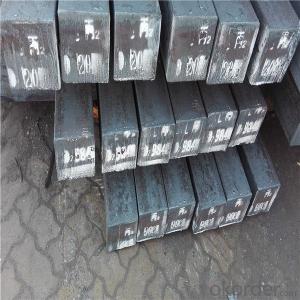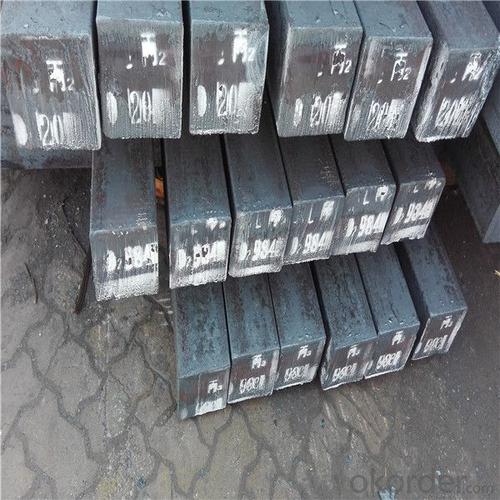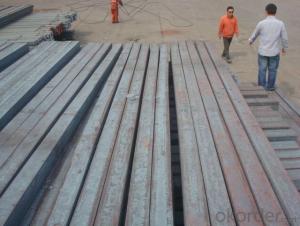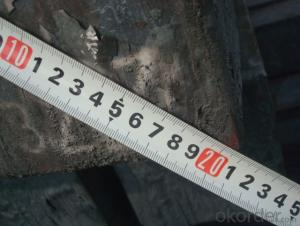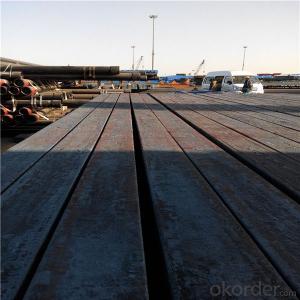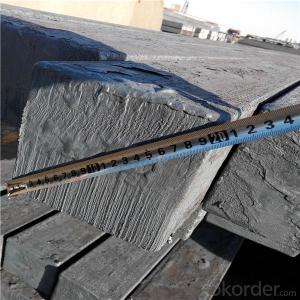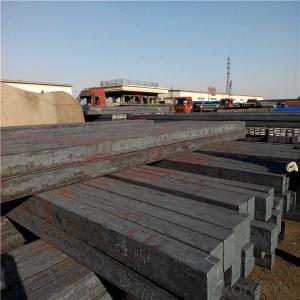Carbon steel billet price for sale from china
- Loading Port:
- China main port
- Payment Terms:
- TT OR LC
- Min Order Qty:
- 1000 m.t.
- Supply Capability:
- 25437 m.t./month
OKorder Service Pledge
OKorder Financial Service
You Might Also Like
Specification
Steel billet
Rectangular billet continuous casting billet and mainly general carbon steel, low carbon low silicon cold-rolled material, high quality carbon structural steel, high strength low alloy steel, special steel, etc.
The billet is mainly divided into two kinds from the shape:
Slab: cross section width and height of the ratio of the larger, mainly used for rolling plate.
Qaulity:own factory, stable quality
Tolerance: Strictly according to the G/B and JIS standard
Delivery time: within 45 days after receiving the L/C or advanced T/T payment.
Price term: FOB/CIF/ CFR according to clients requirements
Gade:
Standard | C(%) | Mn(%) | S(%) | P(%) | Si(%) |
Q195 | ≤0.12 | ≤0.50 | ≤0.040 | ≤0.035 | ≤0.30 |
Q235 | ≤0.20 | ≤1.40 | ≤0.045 | ≤0.045 | ≤0.35 |
Q275 | ≤0.22 | ≤1.50 | ≤0.045 | ≤0.045 | ≤0.35 |
20MnSi | 0.17-0.25 | 1.2-1.6 | ≤ 0.050 | ≤ 0.050 | 0.40-0.80 |
3SP | 0.14-0.22 | 0.40-0.85 | ≤ 0.050 | ≤ 0.040 | 0.05-0.15 |
5SP | 0.28-0.37 | 0.50-1.00 | ≤ 0.050 | ≤ 0.040 | 0.15-0.30 |
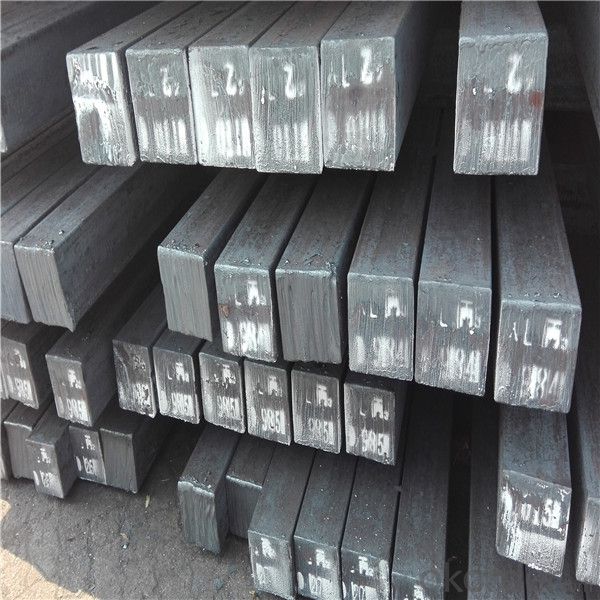
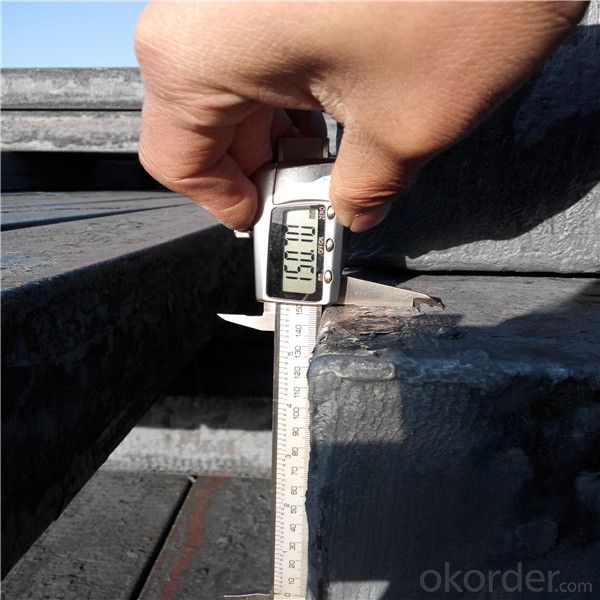
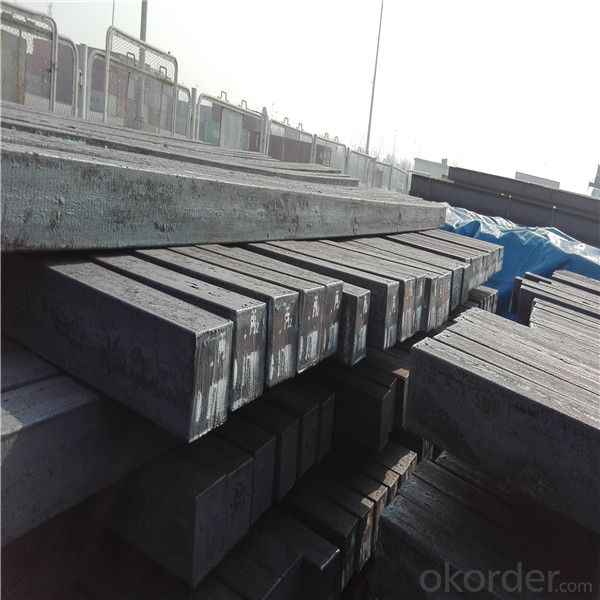
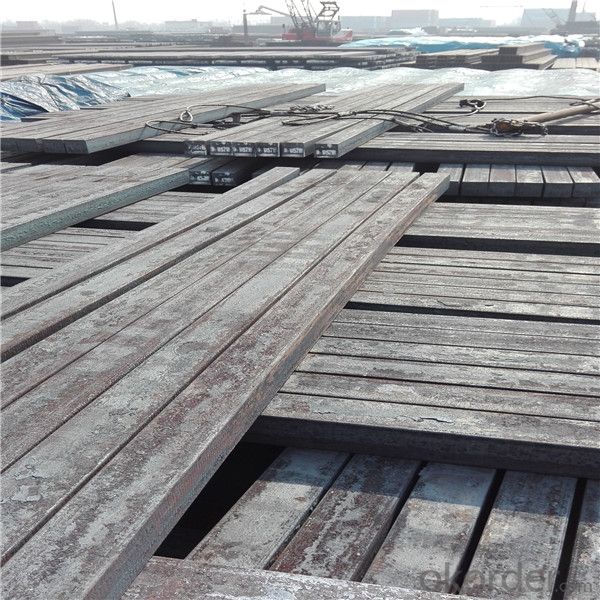
Our service :
We have a plant and professional team to provide our best service, from the start of production until the
loading into the vessel, we have a complete quality follow up procedure, to assure our products arrives to the customer with satisfaction. Welcome new and old customers
to contact us for future business relationships! We will give you a surpise price.
Packing :
Within 30 days
1.Standard export package
2.In bundles with steel strips
3.As the requirements of the customers
FAQ:
Q: What is payment terms?
A: FOB 30% T/T IN ADVANCE AS DEPOSIT AND 70% T/T BEFORE SHIPMENT
CIF and CFR 30% T/T IN ADVANCE AS DEPOSIT AND 70% T/T AS THE COPY OF B/L OR L/C AT SIGHT
Q:How to guarantee the quality of the products?
A:We have established the international advanced quality management system,every link from raw material
to final product we have strict quality test;We resolutely put an end to unqualified products flowing into the market.
At the same time, we will provide necessary follow-up service assurance.
Q:How long can we receive the product after purchase?
A :In the purchase of product within three working days, We will arrange the factory delivery as soon as possible.
The pecific time of receiving is related to the state and position of customers.
- Q: How are steel billets stored to prevent rusting?
- Steel billets are stored to prevent rusting by implementing several measures. Firstly, they are typically kept in a dry and controlled environment with low humidity levels. This helps to minimize the presence of moisture, which is one of the primary causes of rusting. In addition, steel billets are often coated with a protective layer, such as oil or a rust inhibitor, to create a barrier between the metal surface and the surrounding atmosphere. The coating acts as a shield against moisture and oxygen, preventing them from coming into contact with the steel and causing rust. Furthermore, steel billets are often stored off the ground to minimize the risk of moisture absorption. This is typically achieved by using pallets or racks that elevate the billets, allowing air to circulate freely around them and reducing the chances of condensation and rust formation. Regular inspection and maintenance are also crucial in preventing rusting. Any signs of corrosion or damage to the protective coating should be promptly addressed to ensure the integrity of the steel billets. By implementing these storage practices, steel billets can be effectively safeguarded against rusting, maintaining their quality and usability for extended periods of time.
- Q: How are steel billets used in the production of structural steel?
- Structural steel production relies heavily on steel billets, which are indispensable for the manufacturing process. These semi-finished steel products serve as the initial material, from which the transformation begins. To initiate the production of structural steel, scrap steel is melted in a high-temperature furnace. Once the steel reaches its liquid state, it is poured into molds that give it a solid, rectangular shape with a uniform cross-section. After the billets solidify, they are transported to a rolling mill. In this facility, the billets are reheated to a specific temperature and passed through a series of rollers. With each pass, the billets progressively undergo size and shape reduction. This crucial step, known as hot rolling, refines the mechanical properties of the steel. The hot-rolled billets then proceed to various techniques, including forging, extrusion, or casting, to achieve specific shapes and sizes required for structural applications. These techniques enable the transformation of the billets into beams, columns, plates, or other components necessary for construction projects. Once the desired shape is attained, the structural steel undergoes several treatments to enhance its strength, durability, and resistance to corrosion. Heat treatment, surface coating, and additional alloying elements may be employed for this purpose. Ultimately, the finished structural steel products find application in a wide range of projects, including the construction of buildings, bridges, and infrastructure. The consistent size and shape of the steel billets ensure that the resulting components possess the necessary strength, stability, and structural integrity to withstand the loads and stresses they will encounter. In conclusion, the importance of steel billets in structural steel production cannot be overstated. They serve as the fundamental material that undergoes various processes to achieve the desired shapes and sizes required for construction. The quality and uniformity of the billets are paramount in ensuring the strength and durability of the final structural steel products.
- Q: What are the different types of cleaning methods used for steel billets?
- Steel billets can be cleaned using several methods, each with specific requirements and desired results. Here are some commonly used cleaning methods for steel billets: 1. Acid cleaning: To eliminate rust, scale, and grease, acid solutions are applied. This method effectively removes tough stains and corrosion, but it necessitates careful handling and proper disposal of acidic waste. 2. Shot blasting: High-speed projectiles are used to impact the surface of steel billets, removing rust, scale, and other impurities and leaving a polished finish. Shot blasting is often employed for large-scale cleaning and can be automated for efficiency. 3. Pickling: Steel billets are submerged in an acid solution, typically hydrochloric or sulfuric acid, to eliminate oxide layers and impurities, resulting in a clean and corrosion-resistant surface. 4. Ultrasonic cleaning: By agitating a cleaning solution with high-frequency sound waves, microscopic bubbles are created, aiding in the removal of dirt, grease, and contaminants from the steel billet's surface. This method is particularly effective for fine particles and hard-to-reach areas. 5. Electrolytic cleaning: A direct electric current is used to attract surface impurities from the steel billets. Immersed in an electrolyte solution, the billets undergo cleaning as the impurities adhere to an electrode. 6. Chemical cleaning: Specialized chemicals are employed to dissolve or react with surface contaminants like rust, oil, or paint. The choice of chemicals depends on the type of contaminant and the desired outcome. Chemical cleaning effectively removes both organic and inorganic substances from steel billets. In conclusion, these various cleaning methods offer diverse approaches to achieve a clean and polished surface for steel billets, ensuring their quality and suitability for further processing or applications.
- Q: How are steel billets used in the manufacturing of medical devices?
- Steel billets are used in the manufacturing of medical devices in various ways. Firstly, steel billets serve as a raw material for the production of surgical instruments, such as scalpels, forceps, and scissors. These devices require a high level of strength, durability, and corrosion resistance, which steel billets can provide. Additionally, steel billets are used in the manufacturing of implants, such as joint replacements and dental implants. These devices need to be able to withstand the load and stress exerted by the human body, and steel billets are an ideal material due to their excellent mechanical properties. Moreover, steel billets are used in the production of medical equipment, such as hospital beds, wheelchairs, and surgical tables. These devices require a sturdy and robust structure, and steel billets can provide the necessary strength and stability. Furthermore, steel billets are also utilized in the manufacturing of medical equipment components, such as brackets, frames, and supports. These components play a crucial role in the functioning and stability of medical devices, and steel billets are often chosen due to their high machinability and weldability. Overall, steel billets are an essential raw material in the manufacturing of various medical devices. Their strength, durability, corrosion resistance, and other mechanical properties make them a suitable choice for producing surgical instruments, implants, medical equipment, and their components.
- Q: What shape is the billet?
- Material standardThickness range: 150-240mm +/-5mm, width range: 880-1530mm +/-20mmLength range: 3700-10000mm +/-500mmCross section size: 64*64; 82*82; 98*98; 124*124; 152*170mm; 120*150; 152*164;Length: 9000mmSection tolerance: square billet: +1.0/-2.0----+3.0/-1.0mm slab: width: +/-2.0MM thickness: +/-3.0MMLength tolerance: +/-200MMDiagonal tolerance of section: 3.5-8.0MMBillet cross section dimension requirements: <1242MM, not allowed; =1242MM, <=2MM, >1242MM, <=3MMBreaking (shear) expansion deformation: <1242MM square billet: no control; slab: <=15MMSurface inclination: no more than 0.1 of the bloomBending length: not more than 10MM per 1MTwist: length <=5M, <=11. Length <=7.5M, <=5.Material 3SP/PS, chemical composition,%:C, Mn, Si, S, P
- Q: What is the chemical composition of steel billets?
- The chemical composition of steel billets typically consists of iron as the primary element, along with varying amounts of carbon, manganese, silicon, sulfur, and phosphorus. The exact composition may vary depending on the specific grade and intended use of the steel billets. Carbon is usually present in small amounts, typically ranging from 0.02% to 0.5%, as it helps to increase the strength and hardness of the steel. Manganese is often added to improve the toughness and hardenability of the steel, while silicon helps in deoxidizing the metal and enhancing its strength. Sulfur and phosphorus are impurities that are typically kept at low levels, as they can negatively affect the mechanical properties of the steel. Additionally, small amounts of other elements such as chromium, nickel, and molybdenum may be added to enhance specific properties of the steel, such as corrosion resistance or high-temperature strength.
- Q: How do steel billets contribute to the manufacturing of electrical appliances?
- Steel billets are used in the manufacturing of electrical appliances as they serve as a raw material for various components. These billets are transformed into sheets, wires, or rods which are then used to create the outer casings, frames, or conductive elements of the appliances. The strength and durability of steel make it an ideal choice for ensuring the longevity and safety of electrical appliances.
- Q: What are the main differences between hot-rolled and cold-rolled steel billets?
- The main differences between hot-rolled and cold-rolled steel billets lie in the manufacturing process and the resulting characteristics of the steel. Hot-rolled steel billets are produced at high temperatures, resulting in a rougher surface and less precise dimensions. They are more malleable and ductile, making them suitable for applications that require shaping or bending. On the other hand, cold-rolled steel billets are manufactured at room temperature, resulting in a smoother and more precise surface finish with tighter dimensional tolerances. Cold-rolled steel billets are stronger and exhibit better surface hardness, making them ideal for applications that require strength, precision, and a superior surface finish.
- Q: What are the main factors affecting the hardness of steel billets?
- The hardness of steel billets is primarily determined by various factors. Firstly, the carbon content plays a vital role in determining steel hardness. Higher carbon content leads to increased hardness as carbon atoms occupy spaces between iron crystals, forming stronger bonds and enhancing material resistance to deformation. Secondly, the inclusion of alloying elements significantly affects steel hardness. Elements like chromium, molybdenum, and vanadium create solid solutions with iron, altering its crystal structure and strengthening the material. These elements facilitate the formation of fine and uniform microstructures, resulting in higher hardness. The heat treatment process is another crucial factor that impacts steel billet hardness. Controlled heating and rapid cooling, such as quenching and tempering, cause a transformation in the crystal structure of steel. This transformation, known as martensitic transformation, increases hardness by generating a high concentration of dislocations and reducing grain size. Furthermore, the cooling rate during solidification also affects steel billet hardness. Rapid cooling, like water quenching, promotes the formation of a fine microstructure and enhances hardness. Conversely, slower cooling rates allow for the growth of larger grains, leading to reduced hardness. Lastly, the presence of impurities and non-metallic inclusions can adversely affect steel billet hardness. These impurities disrupt the crystal lattice, reducing material strength and hardness. Therefore, the purity and cleanliness of the steel composition are crucial for achieving higher hardness levels. In conclusion, several factors, including carbon content, alloying elements, heat treatment processes, cooling rate, and the presence of impurities, influence the hardness of steel billets. To attain the desired hardness properties, it is essential to comprehend and control these factors.
- Q: What are the different surface defects that can occur in steel billets?
- Steel billets can suffer from a variety of surface defects. Among the most common are: 1. Scale: During heating, a rough, flaky oxide layer known as scale can form on the billet's surface. This coating can negatively impact the final product's quality. 2. Cracks: Thermal stress, improper handling, or excessive cooling can cause cracks to appear on the billet's surface. These cracks can be either longitudinal or transverse and compromise the overall structural integrity of the billet. 3. Decarburization: High temperatures or chemical reactions can lead to the reduction of carbon content at the steel's surface, a process known as decarburization. This weakens the outer layer, affecting the billet's mechanical properties. 4. Pits: Corrosion, inadequate cleaning, or chemical reactions can result in small depressions or cavities on the billet's surface, known as pits. Pits can reduce strength and create localized stress concentrations. 5. Surface roughness: Improper handling, insufficient machining, or poor surface finishing can leave steel billets with uneven or rough surfaces. This can impact the final product's appearance and performance. 6. Inclusions: Non-metallic materials become trapped in the steel during manufacturing, forming inclusions. They can appear as dark spots, streaks, or irregular shapes on the billet's surface. Inclusions weaken the steel and decrease its ductility. 7. Surface contamination: Handling or storage can introduce foreign materials like dirt, oil, or grease to steel billets, leading to surface defects, corrosion, or compromised quality. Detecting and addressing these surface defects early in the manufacturing process is crucial to ensure high-quality steel billets. Various inspection techniques, including visual examination, ultrasonic testing, and magnetic particle inspection, can be used to identify and mitigate these defects.
Send your message to us
Carbon steel billet price for sale from china
- Loading Port:
- China main port
- Payment Terms:
- TT OR LC
- Min Order Qty:
- 1000 m.t.
- Supply Capability:
- 25437 m.t./month
OKorder Service Pledge
OKorder Financial Service
Similar products
Hot products
Hot Searches
Related keywords
